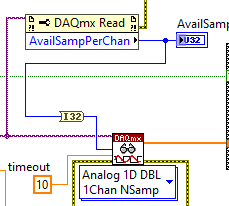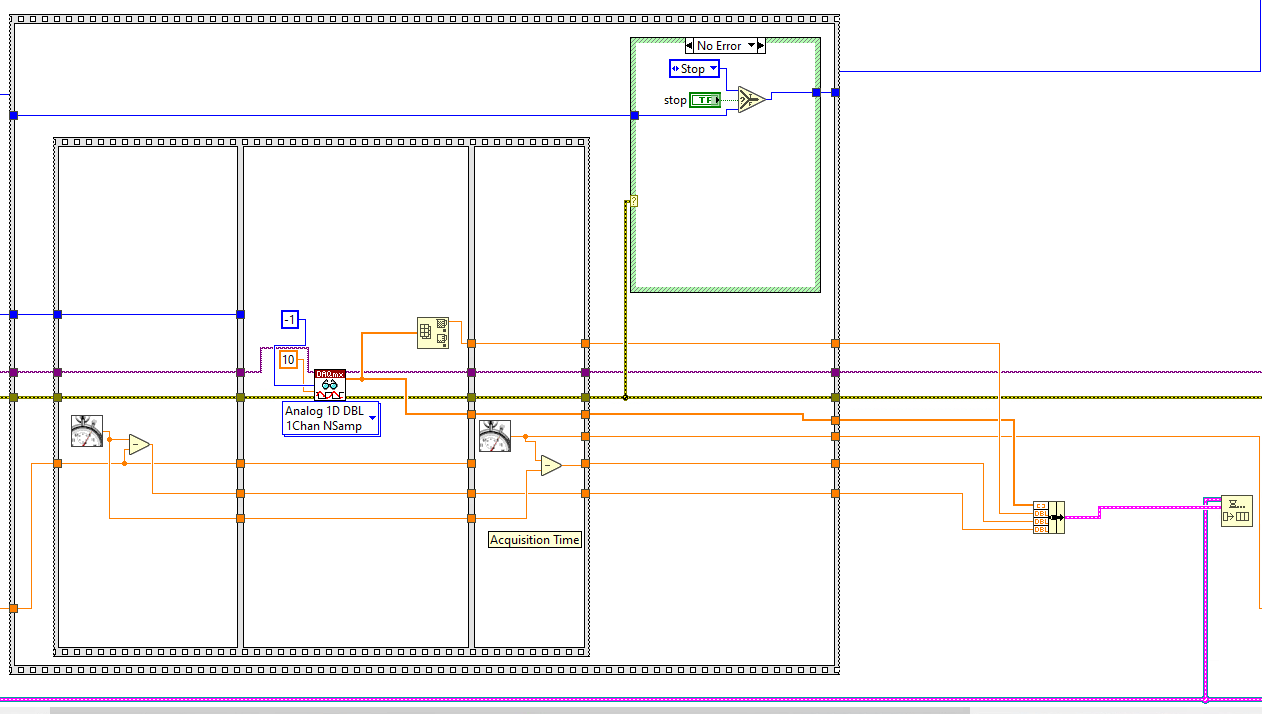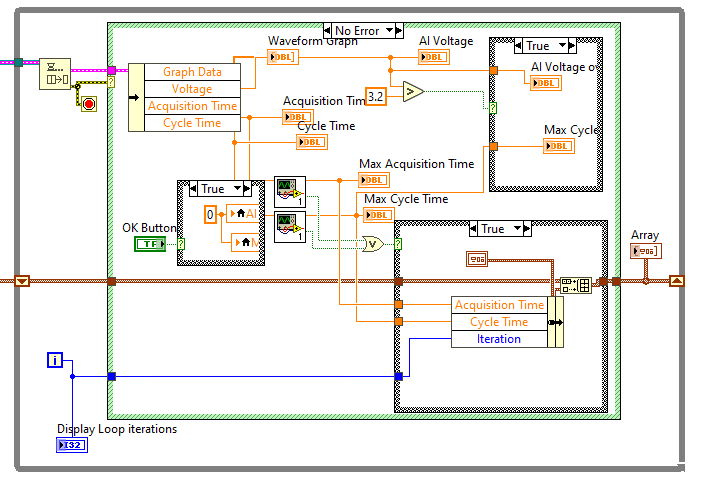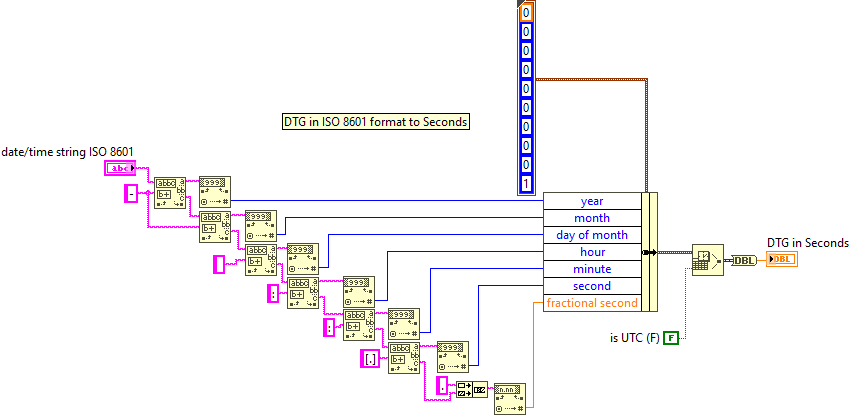
rharmon@sandia.gov
Members-
Posts
91 -
Joined
-
Last visited
-
Days Won
1
rharmon@sandia.gov last won the day on June 12 2020
rharmon@sandia.gov had the most liked content!
Profile Information
-
Gender
Male
-
Location
Livermore, CA
LabVIEW Information
-
Version
LabVIEW 2009
-
Since
1992
Contact Methods
- Company Website
Recent Profile Visitors
33,365 profile views
rharmon@sandia.gov's Achievements
-
I've returned to continuous samples, I set my rate to 100000 and samples per channel to 1000 and on my DAQmx Read.vi I've hard-wired Number of Samples Per Channel = 10000 (1/10th of my rate) when I interject my own 90 usec pulse I catch every pulse. But I'm worried, the only difference from my old setup which could run for months before getting a buffer overflow error is the hard-wired Number of Samples Per Channel = 10000. In the past I used the DAQmx Read Property Node to check Available Samples Per Channel and would read that value instead of the now hard-wired value. Does my current setup sound appropriate to catch the random 90 usec pulses? Rate = 100000 Samples per Channel = 1000 Hard-wired into the DAQmx Read.vi Number of Samples Per Channel = 10000 (1/10th of my rate) Thanks, Bob
-
Using Continuous Samples I had problems with buffer over flows errors -200279
-
I'm trying to catch/count a random 90 usec pulse. I'll admit I'm just using brute force.... I'm acquiring Finite Samples, 100000 samples per channel (just one channel) at a rate of 200000 on a PXIe-6341, when I'm confident this test is working it will run for a year. Interjecting my own 90 usec pulse I catch the pulse 100 times out of 100 attempts. That part I like... I define Acquisition Time as the time it takes to acquire my huge acquisition and Cycle Time as the time it takes to queue my acquisition and circle back for the next acquisition. There are other things happening on this computer, but this vi only acquires this acquisition. Acquisition time is .502 seconds and Cycle Time is .0000207 seconds so if my pulse is 90 usec and my cycle time is 20 usec I should always catch the pulse. I think. Now for the part that concerns me... I've run this test for days and I'm catching the Max Cycle Time and Max Acquisition Time catching being every time the value is larger than the last largest value I toss it into an array (I only have 28 elements in this array over a several day period). My Max Acquisition Time is .5139955, however my Max Cycle Time is .0002743 considerably larger then my 90 usec pulse. I've moved almost everything out of the acquisition loop, I just don't know what to try next. Is there a way to prioritize this? Any thoughts? Thanks in advance... Bob
-
I'm missing something here
rharmon@sandia.gov replied to rharmon@sandia.gov's topic in LabVIEW General
ooth, Thank you so much... That was the issue... I should have guessed... Right!!!! Really appreciate your help... Bob -
Trying to modify this code I found online (Editing Individual Cells in an Excel File.vi), but whenever I right click on a property node I get "No Properties" or "No Methods". I think it's because the Active X for excel isn't loaded or enabled but I'm not sure. I tried to select the Active X Class, what comes up is Version 1.3, but I don't have a clue what to change it to... I tried ExcelTDM 1.0 Type Library Version 1.0, but that didn't work. Any ideas or help would be greatly appreciated... Thanks Editing Individual Cells in an Excel File.vi
-
Thanks for your great explanation. As I look into modifying/correcting my issue changing to UTC time would be very involved and probably take more time then I have available to accomplish. I'm leaning toward just changing the DST to -1 and moving on. Just so I think I understand, by changing DST to -1 the operating system will make the corrections for Daylight Savings... When we leap forward... My data will be appear to be missing one hour of data. The data will still be taken, but the timestamp will increase making it appear I lost one hour of data. And when we fall back my data will appear to take one hours data again. The data will still be correct, it will just appear I have taken two sets of data during that one hour... Does that make any sense at all???? My head is spinning. Thank you all again...
-
Wow, I think I'm happy this Daylight Savings hasn't just bit me... Sorry guys but I'm always happier in a full boat, even if its taking on water!!! I think the overall consensus is to use UTC within the software and convert to Time Zone corrected display for the user. I'm guessing UTC just keeps marching on and never changes for Daylight Savings Time, but my conversion for the user would need to change. I'm guessing to do the conversion I would use the DST value being 0 for standard and 1 for Daylight Savings time to determine how I'm converting. I'm hoping this DST value changes right at Daylight Savings Time. I think all this makes sense. I'm finding it difficult to wrap my hard head around Dr. Powell's comment "I would go with DST=-1. There will be one hour per year (Fall Back) where LabVIEW won't be able to know what the UTC time actually is (as there are two possibilities), but otherwise it would work. Note, though, that i never use that function that you are using." How are there two possibilities about actual UTC Time? I can't have one hour a year when time isn't correct, my luck would have that one hour out of 8,760 hours be the actual time I truly need. Dr. Powell says he never uses Date/Time to Seconds Function... What do you use? What makes your method stronger? I'm sorry, I'm just crazy busy right now and I'm trying to get the answers I need to correct my issue so when I get time, I won't be asking you guys questions... That said I haven't taken the time to look at your Libraries yet. I will soon, I promise. Any extra thoughts, concerns, knowledge would be greatly appreciated. Thanks, Bob
-
I just ran into a problem with my coding... And I think I found the issue, I just don't understand the WHY? After the time change this last weekend, my elapsed time has been off by an hour, it added an hour to the actual elapsed time. My software grabs the time in seconds when something starts and uses the Elapsed Time to calculate how long it's been running. This has been working just fine until Daylight Savings Time hit me. I'm guessing with my DST set to 1 in the cluster constant that for the last several months my elapsed time calculations have been correct because the actual Daylight Savings was 1, but when Daylight Savings Time changed this last weekend this DST should be a 0. The help file for the Date/Time to Seconds Function states the following: DST indicates whether the time is standard (0) or daylight savings time (1). You also can set DST to -1 to have the VI determine the correct time automatically each time you run the VI. If is UTC is TRUE, the function ignores the DST setting and uses Universal Time. This statement tells me I should have set DST to -1 in the cluster constant. My work computer won't allow me to change the date of my computer so I can't think of an easy way to test this. I'm hoping you guys years of experience can tell me if I'm right. I know this works for now, but I don't want the problem to return when we spring forward next spring... Are there pitfalls to setting DST to -1 and just letting the OS take care of Daylight Savings Time? Thanks in advance for your help... You guys always have the right answers... Bob
-
OK, I found my stupid... Right after I posted... I had setup my event structure wrong... too fast on the mouse... I was getting the Previous row/column when they were wrong... Not sure why I got -2 -2... Not going to worry about that now... Thanks for looking at my post and laughing... I'm sorta laughing too...
-
I can't seem to find a consistent means of retrieving the row and column using a mouse click inside a table cell. Property nodes "Edit Cell" and "Selection Start" seem to work sometimes... sometimes I get -2 and -2, but sometimes I even get the wrong row column... It just doesn't seem to make any sense to me... I'm probably doing something really stupid, but I'll be darned if I can figure out what the stupid thing I'm doing???? Thanks
-
Does anyone know of a way to determine from a LabVIEW program if a PXIe-1085 is powered up? Maybe also if it can communicate via PXIe-8301?
-
Thought I'd give a quick update on where I'm at.... But first a HUGE Thank You to everyone here... I can't express what a fantastic resource you guys are. I decided to try Tortoise SVN, mostly because everyone seemed to say it was the easiest to use, for a beginner in SCC I thought that very important. So far so good... I created a repository on my computer and (terminology is going to bite me here) Imported my project. It all appears to be fine so far... I know small steps.... This week has been crazy busy.. I'm hoping to actually change some vi's today and see how that goes. Next question... Where to keep the repository... I'm just far enough in that if I needed to start over with a new repository I wouldn't be so bad. I actually tried to start the repository on a TeamForge site but got an error something about Tortoise SVN not supported something to do with DAV whatever that is. I plan to look into this a bit more today. But back to the question... I've tried using a LabVIEW Project that was on a network drive at work, and working from home was painful. LabVIEW would lock up looking for the network drive sometimes for up to 20 seconds... Drove me crazy... This is going to surprise everyone, but I'm horrible at backing up my laptop. So keeping the repository on my laptop worries me a lot. If I decide to keep it on my laptop I can set it up to sync on a networked drive at work. I don't think this would upset LabVIEW too much, But that is yet to be determined. Other then the obvious that I need to backup my laptop. Any other concerns about keeping the repository on my laptop? Thanks again to everyone... You are all amazing....
- 26 replies
-
- source code control
- subversion
-
(and 3 more)
Tagged with:
-
Eric, I think you are exactly right... My thoughts of a branch was I have a software package and probably 90% of that code will be used in another project. I was thinking I would just branch off the second project and make the necessary changes to make the second project work. It would not be my intension to ever re-unite the branches. Thank you for catching my mistake... You have probably saved me from a future huge headache....
- 26 replies
-
- source code control
- subversion
-
(and 3 more)
Tagged with:
-
Great Information... I think reading through these posts I'm leaning toward Subversion or Mercurial... Probably Mercurial because from my conversation leading me toward source control touched on the need to branch my software to another project. Next step... download the software on another computer (so I don't endanger my current projects) and give it a try. I can't express how helpful these posts have been, It would have taken me days to try all different source control options available... Just read Crossrulz's reply and it states "just don't branch and you will never have to worry about merging" Cool.... I guess I'll just have to cross that bridge when the time comes. Thank you to everyone who replied... Now I'm going to go jump in the source control pool... It's cold outside I hope the water is warm...
- 26 replies
-
- source code control
- subversion
-
(and 3 more)
Tagged with:








